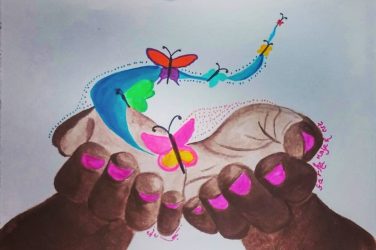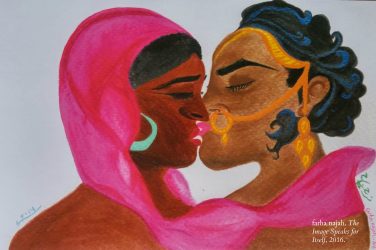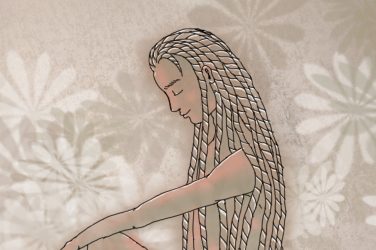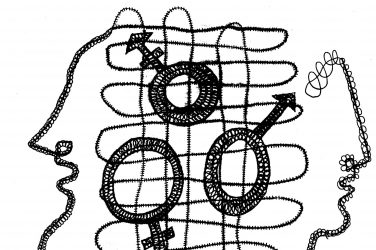Artists in Montreal do essential work in making claims to the city that often go unrecognized in the more official debates about its pasts and possible futures.1 Keeping with many traditions of resistance both within and outside institutions, the exhibition While No One Was Looking is a public intervention by a group of local artists and scholars in response to the city’s 375th anniversary celebrations and their politics of commemorating city life and residents and, relatedly, Canada’s 150-year anniversary. Drawing from Sherene Razack’s argument that “social change is not so much about new information, as it is disrupting the hegemonic ways of seeing”, While No One Was Looking places stories, and versions, of the city in opposition with dominant narratives of commemoration in Montreal’s 375th anniversary events.2
The title, While No One Was Looking, is a wry reference to the questions of who is “seen” and whose stories and histories are actively ignored by the mainstream – a calculated art of “not looking” that often occurs in conjunction with heavy surveillance. It is at this very juncture of invisibility and hypervisibility that certain individuals, groups, and actions can counter erasure and scrutiny. The artists within the exhibition – Fanny Aïshaa, Ifeoma U. Anyaeji, Ma’liCiouZ, Cécilia Bracmort, JJ Levine, Shanna Strauss, and Kevin Calixte – all assert different notions of community, belonging, and resistance. Collectively, these experiences and stories question the ways in which we share, imagine, and make space.
Commenting on the irony of the celebrations around the 375th anniversary of Montreal, Fanny Aïshaa’s acrylic paintings underline the importance of revering the connection to the land and the life-sustaining waters of Montreal. Aïshaa states: “I feel it is important to present a piece about the stewardship of water that is threatened by more oil traffic tankers, a proposed pipeline, water waste, and a way of life that disconnects us from this precious source of life. We need to acknowledge in actions the Nations that have been here long before this anniversary of the colonisation of Montreal and have protected the wealth and abundance that we are benefitting from today.”3 Her pieces, Eau sans pétrole (Pas de pipeline, Pas de pétrole, Pas de problème) (2015), inspired by a photograph by Michaela McGuire, and Sans titre (Protecteurs) (2016), based on a photograph by Ossie Michelin, call for a redirection of financial resources used for Montreal celebrations towards “natural conservation and celebrating visions that will permit citizens more autonomy and wellness.”4
Similarly, Ifeoma U. Anyaeji also upholds the importance of sustainability in everyday life through her practise of upcycling: “Using a style of upcycling I developed, called Plasto-art, I repurpose discarded non-biodegradable plastic bags with a receding traditional hair-plaiting technique, from my home country Nigeria, called Threading or African Hair Threading.”5 In combining these techniques, Anyaeji’s installations, A no m’eba, ma na anoho mu eba (I am here, but I am not here – Presence, absence) (2014-2016) and Queen Eliza (2015), speak to the social and environmental adjustments and amalgamations which must be made by many in order to “fit into” mainstream society or to uphold any sort of essence. Anyaeji describes this as “the constant need to justify [her] cultural existence and renew its relevance in an ever-changing society, challenging the line between newness and the new including how one [she] wants to be perceived.”6
Also reflecting on what identity means for diasporic bodies, Ma’liCiouZ produces portraits which consider Black identity in contemporary society, offering a counter narrative to predominant representations of Blackness and making visible those who are often overshadowed by the mainstream. Like Fanny Aïshaa, Ma’liCiouZ also works as a muralist and the space that her large-scale works take up is crucial to their meaning. Ma’liCiouZ indicates that « Dans la réalisation de murales, la taille imposante des personnages est corrélée avec l’importance, la prestance et la force d’esprit des femmes de sociétés matriarcales dont je m’inspire. »7
Likewise, Cécilia Bracmort’s photographic series Imprinted on My New Place (2017) documents her deepening understanding of Montreal’s colonial histories. The photographs bear witness to the reckoning of her ambivalent feelings in perpetuating the settler colonial occupation of unceded Indigenous territories as an immigrant to this land. “As a black woman (originating from the French Antilles) my identity is forged through the atrocities of colonization of this continent and slavery, although, as a French Immigrant, accepted by Canadian and Québecois institutions, I occupy a territory [that is] originally stolen. What is my place and my role in this history? What will my presence give to this complex history?”8 Bracmort’s questions underline the importance of BIPOC solidarities and collective resistance to oppressive hegemonies through community building.
Community, alternative, queer and trans family structures, and kinship bonds are at the heart of JJ Levine’s photography project Queer Portraits. Having explored these notions over the past decade, Levine utilizes domestic settings to “raise questions regarding private space as a realm for the development of community and the expression of genders and sexualities that are often marginalized within the public sphere […] These relationships stand in direct contrast to mainstream, capitalist, isolationist notions of family structure [and] propose a counter narrative as I document and archive our lived realities.”9
Likewise, in their collaborative and ongoing series, Changemakers (2016-), Shanna Strauss and Kevin Calixte seek to push back against essentializing notions of community and of collective resistance. They explain, “this project seeks to dismantle public discourses that essentialize and homogenize Black communities and Black women.”10 Strauss and Calixte aim to highlight the forms of resistance and changemaking that exist in the everyday. They assert that activism and community work that occurs on smaller scales, away from the public eye, is as important as social justice work that takes place in the public spotlight.
The city’s 375-year anniversary events primarily highlight narratives of colonial triumph over stories of colonial violence in Montreal and Canada, sidelining histories of resistance and survival that live on today in contemporary activism, art and public engagement. Canadian museums, galleries and civic celebrations also play a role in these stories of triumph and domination. Through their storytelling and production of artistic meaning, exhibitions and events “form the political economy of cultural production.”11 While anniversary events have provided institutions and the public with opportunities to contest colonial misrepresentation and cultural appropriation, they have also inscribed relations of power through their exhibition practices that have often reproduced colonial constructions of race, gender, and class.12 Indigenous artists are contesting the appropriation of Indigenous cultural practices for the Canada 150 celebrations throughout Canada.13 These contestations are the latest in a long history of resistance to a politics of commemoration that portrays Canada as if its histories of colonization have been reconciled.14
The city’s 375-year anniversary events primarily highlight narratives of colonial triumph over stories of colonial violence in Montreal and Canada, sidelining histories of resistance and survival that live on today in contemporary activism, art and public engagement.
While No One Was Looking offers a space for artists from Montreal to share their experiences of life in the city and, in the process, counter what many recognize as the city’s primarily colonial approach to its own histories. Focusing in particular on the written and unwritten histories of the land on which Montreal was colonised, the unceded territory of the Kanien’kehá:ka nation of the Haudenosaunee Confederacy, the exhibition draws from Leanne Simpson, Eve Tuck and K.Wayne Yang, and other scholars and activists whose work calls for, and embodies, a critical relation to the city and the land.1516
Working within a feminist, anti-oppressive framework, the exhibition aims to bear witness to the city through the different positions, and conditions of collaboration and coalition, emerging artists and scholars build together around their experiences, and cultural memories, of the city. While No One Was Looking suggests that cultural memory is a contested and living process, archived in the personal stories of people who have felt the effect of histories of power and resistance in racially marginalized communities, Indigenous communities and LGBTQ+ communities across Montreal.
- Johanne Sloan, Urban Enigmas: Montreal, Toronto, and the Challenge of Comparison between Cities (McGill-Queen’s University Press, 2007), 221-222.
- Sherene H. Razack, Looking White People in the Eye (University of Toronto Press, 1998), 10.
- Artist statement and email exchange.
- Artist statement and email exchange.
- Artist statement.
- Artist statement.
- Artist statement. Translation: “When creating murals, the imposing size of the characters correlates with the importance, the presence, and the strength of mind of the women from the matriarchal societies who inspire me.”
- Artist statement.
- Artist statement.
- Artist statement and email exchange.
- Paul O’Neill, The Culture of Curating and the Curating of Culture(s), (Cambridge, Massachusetts; London, England: The MIT Press, 2012), 90-91.
- See Ruth B. Phillips, Museum Pieces: Toward the Indigenization of Canadian Museums (Montreal: McGill-Queen’s University Press, 2011).
- See Caoimhe Morgan-Feir, “Kent Monkman: History Painting for a Colonized Canada,” Canadian Art, 26 Jan. 2017 (http://canadianart.ca/features/kent-monkman-critiques-canada-150); Deana Sumanac-Johnson, “Telling their stories or opting out: Indigenous artists on Canada 150,” CBC News, 7 Feb. 2017 (http://www.cbc.ca/news/entertainment/indigenous-artists-canada-150-1.3968556); and Anna Maria Tremonti, “What does Canada 150 mean for Indigenous communities?,” CBC’s The Current, podcast, 16 March 2017. (http://www.cbc.ca/radio/thecurrent/the-current-for-march-16-2017-1.4026463/what-does-canada-150-mean-for-indigenous-communities-1.4027484).
- Leah Sandals, “Artists and Allies Resist #Canada150 Push on Social Media.” Canadian Art, 17 Jan. 2017 (http://canadianart.ca/news/artists-resist-canada150-social-media).
- “Land Acknowledgement,” The McGill Daily, (http://www.mcgilldaily.com/aboutus); and “Haudenosaunee: Kahnawake Branch of the Mohawk Nation, Six Nation Iroquois Confederacy,” Kahnawake Longhouse (http://www.kahnawakelonghouse.com).
- See Leanne Betasamosake Simpson, “Land as pedagogy: Nishnaabeg intelligence and rebellious transformation,” Decolonization: Indigeneity, Education, & Society, vol. 3, no. 3 (2014), 1-25; and Eve Tuck and K. Wayne Yang, “Decolonization is not a metaphor,” Decolonization: Indigeneity, Education, & Society, vol. 1, no. 1 (2012), 1-40.















Show Comments (0)